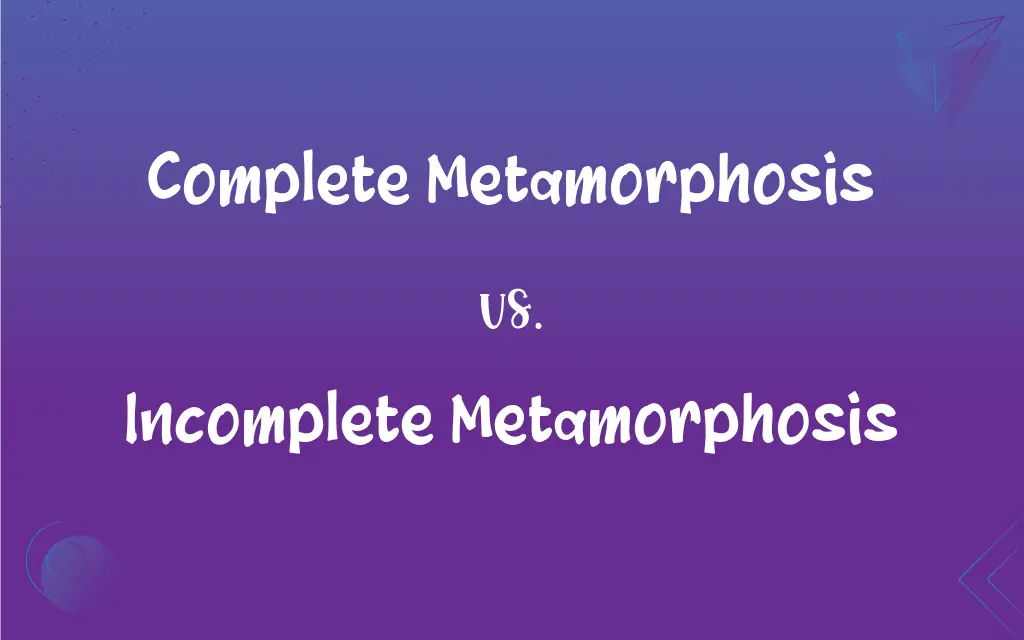Complete Metamorphosis vs. Incomplete Metamorphosis: What's the Difference?
Edited by Janet White || By Harlon Moss || Updated on October 26, 2023
Complete metamorphosis involves four distinct stages: egg, larva, pupa, and adult; incomplete metamorphosis has three stages: egg, nymph, and adult.

Key Differences
Complete metamorphosis encompasses a transformative lifecycle with four stages: egg, larva, pupa, and adult. In contrast, incomplete metamorphosis includes three stages: egg, nymph, and adult.
During complete metamorphosis, organisms undergo a dramatic change in form, as seen in butterflies. In incomplete metamorphosis, changes are more gradual, as observed in grasshoppers.
In complete metamorphosis, the larval stage is distinctly different from the adult form. In incomplete metamorphosis, the nymph stage resembles a smaller version of the adult.
Complete metamorphosis includes a non-feeding pupal stage where transformation occurs. Incomplete metamorphosis lacks this stage; nymphs feed and grow until reaching adulthood.
Complete metamorphosis often involves different habitats and food sources for larvae and adults, reducing competition. In incomplete metamorphosis, nymphs and adults often share habitats and food sources.
ADVERTISEMENT
Comparison Chart
Stages
Egg, Larva, Pupa, Adult
Egg, Nymph, Adult
Transformation
Dramatic change in form
Gradual development, less change
Larval/Nymphal Stage
Larva looks different from adult
Nymph resembles a smaller adult
Pupal Stage
Includes a pupal stage
Lacks a pupal stage
Habitat & Food Source
Often different for larvae and adults
Usually the same for nymphs and adults
ADVERTISEMENT
Complete Metamorphosis and Incomplete Metamorphosis Definitions
Complete Metamorphosis
Process where larvae and adults differ significantly.
In beetles, complete metamorphosis creates a stark contrast between larvae and adults.
Incomplete Metamorphosis
Development with shared resources across stages.
Incomplete metamorphosis in locusts leads to shared habitats and food sources for nymphs and adults.
Complete Metamorphosis
Transformation including a pupal stage.
Complete metamorphosis in moths includes a cocoon-forming pupal stage.
Incomplete Metamorphosis
Lifecycle with less dramatic physical changes.
In incomplete metamorphosis, praying mantises grow gradually without drastic changes.
Complete Metamorphosis
A development cycle reducing resource competition.
Complete metamorphosis in dragonflies aids in reducing competition for food between stages.
Incomplete Metamorphosis
A lifecycle with three stages.
Grasshoppers undergo incomplete metamorphosis, skipping the pupal phase.
Complete Metamorphosis
A lifecycle with four distinct stages.
The butterfly's complete metamorphosis is a captivating transformation.
Incomplete Metamorphosis
Gradual development without a pupal stage.
Incomplete metamorphosis in crickets involves a direct progression from nymph to adult.
Complete Metamorphosis
Lifecycle with dramatic physical changes.
Frogs undergo complete metamorphosis, evolving from tadpoles to adults.
Incomplete Metamorphosis
Process where nymphs resemble adults.
Cockroaches exhibit incomplete metamorphosis, with nymphs looking like smaller adults.
FAQs
Do organisms in complete metamorphosis change habitats?
Often, as larvae and adults in complete metamorphosis may have different habitats and food sources.
What is complete metamorphosis?
It's a lifecycle with four stages: egg, larva, pupa, and adult, involving dramatic changes.
Can you give an example of complete metamorphosis?
Butterflies are a classic example, transforming from caterpillars to adults.
What is incomplete metamorphosis?
It's a lifecycle with three stages: egg, nymph, and adult, with more gradual changes.
Do larvae and nymphs compete for resources?
In complete metamorphosis, larvae and adults often have different food sources, reducing competition. In incomplete metamorphosis, nymphs and adults may compete for similar resources.
Are metamorphosis processes the same in all environments?
Environmental factors can influence the duration and specifics, but the basic stages remain consistent.
Are metamorphosis processes species-specific?
Yes, whether an organism undergoes complete or incomplete metamorphosis depends on its species.
Can metamorphosis be reversed?
No, metamorphosis is a one-way developmental process.
Does complete metamorphosis offer evolutionary advantages?
It can, by reducing competition for resources and allowing for specialization in different life stages.
Is metamorphosis unique to insects?
While common in insects, other animals like amphibians also undergo metamorphosis.
Does human intervention affect metamorphosis?
Factors like habitat destruction and pollution can impact metamorphosis processes.
Is there a pupal stage in incomplete metamorphosis?
No, incomplete metamorphosis lacks a pupal stage.
What's an example of incomplete metamorphosis?
Grasshoppers, which develop directly from nymphs to adults.
Does incomplete metamorphosis involve a cocoon or pupa?
No, it bypasses this stage entirely.
How do larvae and nymphs differ in these processes?
Larvae in complete metamorphosis look very different from adults, while nymphs in incomplete metamorphosis resemble smaller adults.
Are the changes in incomplete metamorphosis dramatic?
No, changes are more gradual compared to complete metamorphosis.
Is complete metamorphosis common in insects?
Yes, many insects, like butterflies and beetles, undergo complete metamorphosis.
Is the adult stage reached faster in complete or incomplete metamorphosis?
In incomplete metamorphosis, since it involves fewer stages and changes are more gradual.
Do both processes involve an egg stage?
Yes, both begin with an egg stage.
Are the adult forms in incomplete metamorphosis always larger than nymphs?
Generally, yes, adults are larger and more developed.
About Author
Written by
Harlon MossHarlon is a seasoned quality moderator and accomplished content writer for Difference Wiki. An alumnus of the prestigious University of California, he earned his degree in Computer Science. Leveraging his academic background, Harlon brings a meticulous and informed perspective to his work, ensuring content accuracy and excellence.
Edited by
Janet WhiteJanet White has been an esteemed writer and blogger for Difference Wiki. Holding a Master's degree in Science and Medical Journalism from the prestigious Boston University, she has consistently demonstrated her expertise and passion for her field. When she's not immersed in her work, Janet relishes her time exercising, delving into a good book, and cherishing moments with friends and family.































































